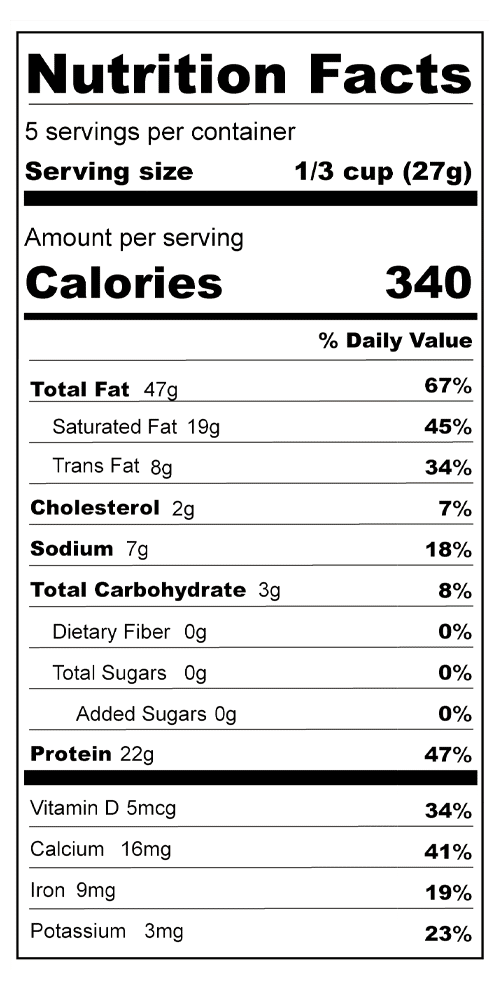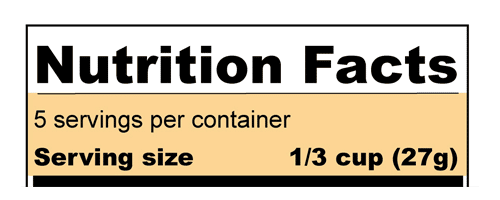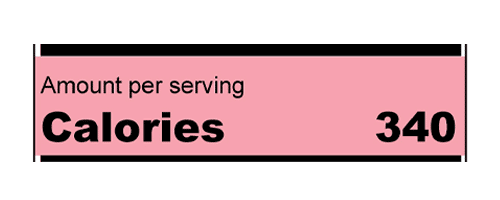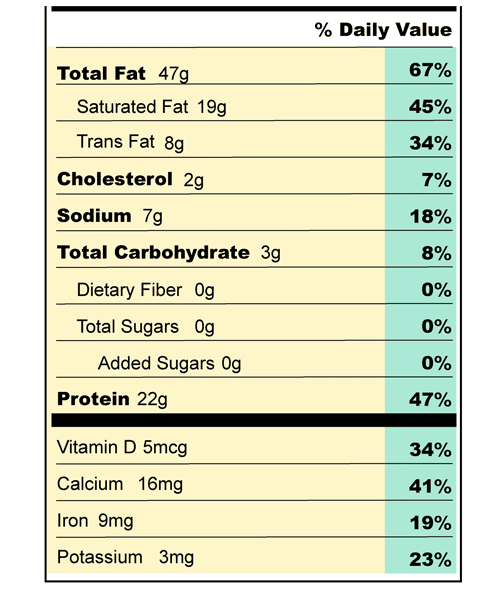Everything You Should Know About The Nutrition Facts Label

Example of a Nutrition Facts Label
The nutrition facts label is one of the most important labels in the food and supplement space. It contains all of the essential nutritional information of each product in a concise and simple-to-understand format. Understanding its details allows consumers to make quick and informed decisions when choosing which products to buy so they can build a more balanced diet. Here is everything you need to know about nutrition facts labels.
What is a Nutrition Facts Label?
A nutrition facts label is a label that is required on every packaged or processed food or beverage. It offers a general overview of the product makeup and product-specific information on the serving size, calories, nutrients, and percent daily value (%DV). Additionally, it provides consumers with an opportunity to evaluate their food and beverage options more holistically and achieve their dietary goals.
Nutrition Facts Label VS Supplement Facts Label
Many consumers assume that a supplement facts label is the same thing as the nutrition facts label; however, this is far from the truth. Whereas the nutrition facts label is for food and beverages, the supplement facts label is, quite literally, for dietary supplements. Nutrition fact labels and supplement facts labels appear similar because they share information regarding calories and nutrients. However, if you look closer, the two labels have completely different FDA requirements.
Unlike the nutrition facts label, supplement fact labels must include any dietary ingredient that does not have Reference Daily Intakes (RDIs) or Daily Reference Values (DRVs). RDIs refer to the number of vitamins and minerals that should be consumed daily while DRVs offer the same for fats, carbohydrates, and certain dietary fibers. Additionally, supplement labels must indicate the source of the dietary supplements next to each ingredient, which displays how the supplement was derived.
Another difference is that supplement facts labels are not allowed to list a given nutrient or ingredient at a value of 0. If an ingredient is not present in a supplement, it will not be listed at all. Furthermore, supplement fact labels can list its ingredients as a part of a proprietary blend.
Here is everything you can expect to be on a nutrition facts label:
1. Serving Information

Serving Information Section
The serving information section shows the number of servings in each product in a standardized format. Each serving is listed in general units, such as cups or pieces, followed by its metric amount (in grams or kilograms). You can find this section right underneath the “Nutrition Facts” header. The serving information is standardized so that consumers can easily compare and contrast products that are similar to one another. Keep in mind that the serving size is not a recommendation of how much a consumer should eat or drink. The serving size is an estimated value of how much consumers eat on average. Additionally, it is important to take note that the values listed on the label apply to each serving size, not the entirety of the product.
2. Calories

Calories Section
The calories of a product are found right below the serving information section. As a unit of energy, calories represent how much energy we can get from food after we process it. In simpler terms, calories are a derivative of various components of each meal. It is not a specific ingredient like fats or vitamins. The FDA treats an intake of 2,000 calories as the standard amount all consumers should eat based on the general energy consumption of an average adult with a moderate activity level. However, while this value is the accepted norm, it doesn’t mean it’s a fixed number. Calorie counts can differ per individual depending on his/her age, sex, height, weight, and amount of physical activity. Remember: the number of calories shown on the label indicates how many calories each serving has, not the total amount of calories in the whole product. The calorie count of each product is essential to consumers because it tells them how much of the product they should consume to achieve and maintain healthy body weight.
3. Nutrients
The nutrients section is found underneath the calories section on the label. This section lists all the key nutrients present in a specific product, such as Total Fat, Cholesterol, Sodium, Total Carbohydrates, Protein, Vitamin D, Calcium, Iron, and Potassium. Total Fats are further broken down into Saturated fat and Trans Fat. Total Carbohydrates are broken down into Dietary Fiber, Total Sugars, and Added Sugars. It is very important for consumers to thoroughly evaluate this section and consider how the amount of each nutrient might affect their diet. Being able to tell which nutrients are abundant or lacking in the food you buy is the first step to achieving good health and wellness.

Nutrition section in yellow, %DV section in green
Consumers should be wary of the amounts of saturated fats, sodium, and added sugars in a product because they are associated with adverse health. The lower the amount of these components, the healthier the product. Look for high levels of dietary fiber, vitamin D, calcium, iron, and potassium. These are the nutrients you should get more of. Ultimately, this section will help you identify which products are best to support your dietary needs. It will show you which products you want to eat more of and which products you may want to limit your intake of.
4. Percent Daily Value (%DV)
The Percent Daily Value (%DV) is a percentage of the Daily Value for each nutrient in a product serving. Each percentage indicates the recommended amount of nutrients one should consume each day. The %DV can be found on the right of each nutrient listed in the nutrients section. This section is important because it provides an easy-to-understand overview of how much each nutrient contributes to your total daily diet. Not only that but it also helps you see whether a serving is high or low in a nutrient. Generally, a %DV less than 5% is considered low, while a %DV greater than 20% is considered high. To make the most out of each purchase, consumers should aim for products that have high percentages in dietary fibers, vitamin D, calcium, iron, and potassium. Likewise, consumers should stray away from products with high percentages of saturated fats, sodium, and added sugars. Consumers who consciously check and compare %DV values will be able to discern which products offer the highest nutritional value.
Key Takeaways
At the end of the day, understanding the nutrition facts label is one of the easiest and most important tasks we have as consumers. It is the first step to success when it comes to acquiring proper nutrition and wellness. Consumers who know how to read, understand, and interpret nutrition facts labels will be able to quickly achieve their health and weight goals. For more information about nutrition fact labels and supplement fact labels, contact Paragon Laboratories.


